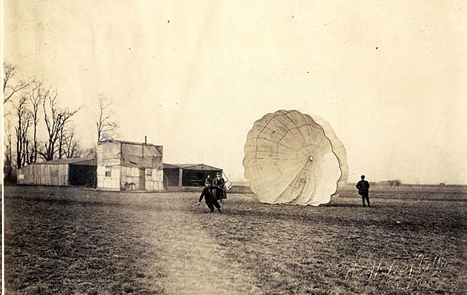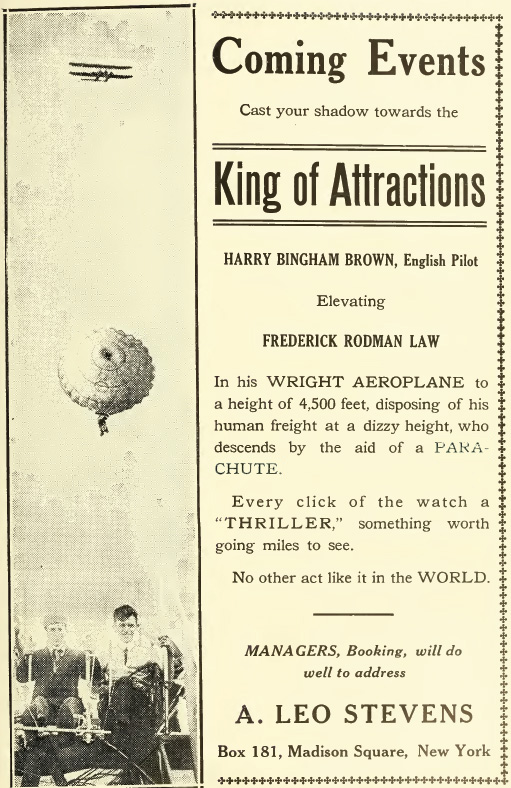Berry’s Leap, Pt. 2
Grant Morton wasn’t the first to parachute from an airplane, or even the second.
Researching yesterday’s post about Albert Berry’s first parachute jump from an airplane, 100 years ago today, made me curious about the other claimant to that honor — Grant Morton — who by some accounts jumped from a Wright Model B airplane flown by Phil Parmelee over Venice, California, in 1911. Most authors have left the matter unresolved as to who really was first. After a little more digging, I think I can settle it.
It was “Bert” Berry, by almost two months. And Morton may not even have been second.
One of the main publications covering aviation at the time was Aeronautics, which put Berry on its March 1912 cover, with the headline “First Parachute Leap From an Aeroplane.” I suppose the magazine’s editors could have been unaware of an earlier jump, but it seems unlikely. And Benoist, the manufacturer of the biplane that Berry leapt from, trumpeted the feat in advertisements for the next couple of issues. No readers came forward to correct them.
Meanwhile, I’ve found no mention, either in newspapers or magazines, of Morton’s jump until April 29, 1912. On that day, at least three newspapers — The Evening World (New York), The Evening Standard (Ogden City, Utah), and The Boston Evening Transcript — carried the news of a parachute jump by “William M. Morton, a professional aeronaut” over Venice the day before. The pilot was indeed Phil Parmelee, and Morton jumped from 2,600 feet. According to The Evening Standard, “The parachute landed in some electric wires and Morton was dropped to the ground, about ten feet, slightly injuring himself. About 40,000 people cheered the feat.” The Boston paper’s headline was “ANOTHER JUMP FROM BIPLANE,” which almost certainly refers to Berry’s leap two months earlier.
Searching through news accounts from the spring of 1912, it’s clear that Berry’s feat led other parachutists, who for years had been jumping from hot air balloons at county fairs, to try to duplicate his stunt. Rodman Law, who had already parachuted from the Statue of Liberty and a Wall Street skyscraper, jumped “from a Burgess-Wright hydroaeroplane flown in Marblehead Harbor by Philip W. Page,” on April 13, according to the April 1912 issue of Aeronautics. By year’s end, Law and his pilot, Harry Bingham Brown, were taking out display ads in the magazine to tout their act.
As for Morton, it’s not clear whether he ever tried another airplane jump. Parmelee died in a crash that June, so Morton would have had to find another pilot.
But if his earlier career as a jumper from balloons is any guide, Morton wouldn’t have been daunted by any setback. Newspaper accounts from the early 1900s — which variously name him as “W.L. Morton,” “Professor W.M. Morton,” “W.N. Morton,” and “Grant Morton” — are full of disasters and near disasters.
All you need are the headlines:
AERONAUT HITS TELEGRAPH POLE (San Francisco Call, May 15, 1905)
THOUSANDS SAW A HORRIBLE ACCIDENT ( Press and Horticulturalist, June 30, 1905)
AERONAUT IS DASHED AGAINST TREE LIMB (San Francisco Call, July 3, 1905)
AERONAUT LANDS IN NEST OF WIRES (Los Angeles Herald, October 22, 1906)
With each mishap, the reporters seemed more eager to count Morton out. My favorite lead (maybe in any story, ever) is this one, in the 1905 Press and Horticulturalist article: “Grant Morton, parachute jumper, was probably fatally injured yesterday…”
Then there’s the Los Angeles Herald story from April 28, 1908, under the headline “BALLOONIST CALMLY AWAITS FOR DEATH,” where we learn (four years before his airplane jump, remember) that “W.L. Morton, the Venice balloonist, now lies dying in the Santa Monica Bay Hospital. Morton has been making almost daily ascensions for a long time past at Venice, dropping to earth in a parachute and taking all kinds of chances at falling on heavily charged live wires or blowing out to sea. He didn’t care, and said so. Yesterday his parachute threw him against a pole near the old alligator place.”
After that, who would mind jumping from a moving biplane?

